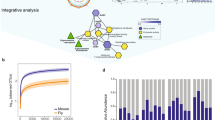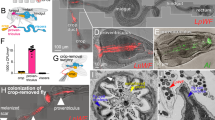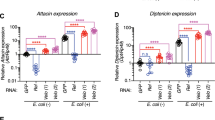Abstract
All metazoan guts are in permanent contact with the microbial realm. However, understanding of the exact mechanisms by which the strength of gut immune responses is regulated to achieve gut-microbe mutualism is far from complete. Here we identify a signaling network composed of complex positive and negative mechanisms that controlled the expression and activity of dual oxidase (DUOX), which 'fine tuned' the production of microbicidal reactive oxygen species depending on whether the gut encountered infectious or commensal microbes. Genetic analyses demonstrated that negative and positive regulation of DUOX was required for normal host survival in response to colonization with commensal and infectious microbes, respectively. Thus, the coordinated regulation of DUOX enables the host to achieve gut-microbe homeostasis by efficiently combating infection while tolerating commensal microbes.
This is a preview of subscription content, access via your institution
Access options
Subscribe to this journal
Receive 12 print issues and online access
$209.00 per year
only $17.42 per issue
Buy this article
- Purchase on SpringerLink
- Instant access to full article PDF
Prices may be subject to local taxes which are calculated during checkout






Similar content being viewed by others
References
Hooper, L.V. & Gordon, J.I. Commensal host-bacterial relationships in the gut. Science 292, 1115–1118 (2001).
Macdonald, T.T. & Monteleone, G. Immunity, inflammation, and allergy in the gut. Science 307, 1920–1925 (2005).
Backhed, F., Ley, R.E., Sonnenburg, J.L., Peterson, D.A. & Gordon, J.I. Host-bacterial mutualism in the human intestine. Science 307, 1915–1920 (2005).
Koropatnick, T.A. et al. Microbial factor-mediated development in a host-bacterial mutualism. Science 306, 1186–1188 (2004).
Lee, W.J. Bacterial-modulated signaling pathways in gut homeostasis. Sci Signal 1, pe24 (2008).
Ha, E.M. et al. Regulation of DUOX by the Gαq-phospholipase Cβ-Ca2+ pathway in Drosophila gut immunity. Dev. Cell 16, 386–397 (2009).
Ha, E.M., Oh, C.T., Bae, Y.S. & Lee, W.J. A direct role for dual oxidase in Drosophila gut immunity. Science 310, 847–850 (2005).
Ryu, J.H. et al. An essential complementary role of NF-κB pathway to microbicidal oxidants in Drosophila gut immunity. EMBO J. 25, 3693–3701 (2006).
Ryu, J.H. et al. Innate immune homeostasis by the homeobox gene caudal and commensal-gut mutualism in Drosophila. Science 319, 777–782 (2008).
Zaidman-Remy, A. et al. The Drosophila amidase PGRP-LB modulates the immune response to bacterial infection. Immunity 24, 463–473 (2006).
Nehme, N.T. et al. A model of bacterial intestinal infections in Drosophila melanogaster. PLoS Pathog. 3, e173 (2007).
Ha, E.M. et al. An antioxidant system required for host protection against gut infection in Drosophila. Dev. Cell 8, 125–132 (2005).
Lemaitre, B. & Hoffmann, J. The host defense of Drosophila melanogaster. Annu. Rev. Immunol. 25, 697–743 (2007).
Uvell, H. & Engstrom, Y. A multilayered defense against infection: combinatorial control of insect immune genes. Trends Genet. 23, 342–349 (2007).
Bischoff, V. et al. Downregulation of the Drosophila immune response by peptidoglycan-recognition proteins SC1 and SC2. PLoS Pathog. 2, e14 (2006).
Ferrandon, D. et al. A drosomycin-GFP reporter transgene reveals a local immune response in Drosophila that is not dependent on the Toll pathway. EMBO J. 17, 1217–1227 (1998).
Tzou, P. et al. Tissue-specific inducible expression of antimicrobial peptide genes in Drosophila surface epithelia. Immunity 13, 737–748 (2000).
Kim, M.S., Byun, M. & Oh, B.H. Crystal structure of peptidoglycan recognition protein LB from Drosophila melanogaster. Nat. Immunol. 4, 787–793 (2003).
Sano, Y. et al. Drosophila activating transcription factor-2 is involved in stress response via activation by p38, but not c-Jun NH2-terminal kinase. Mol. Biol. Cell 16, 2934–2946 (2005).
Han, S.J., Choi, K.Y., Brey, P.T. & Lee, W.J. Molecular cloning and characterization of a Drosophila p38 mitogen-activated protein kinase. J. Biol. Chem. 273, 369–374 (1998).
Han, Z.S. et al. A conserved p38 mitogen-activated protein kinase pathway regulates Drosophila immunity gene expression. Mol. Cell. Biol. 18, 3527–3539 (1998).
Choe, K.M., Werner, T., Stoven, S., Hultmark, D. & Anderson, K.V. Requirement for a peptidoglycan recognition protein (PGRP) in Relish activation and antibacterial immune responses in Drosophila. Science 296, 359–362 (2002).
Gottar, M. et al. The Drosophila immune response against Gram-negative bacteria is mediated by a peptidoglycan recognition protein. Nature 416, 640–644 (2002).
Ramet, M., Manfruelli, P., Pearson, A., Mathey-Prevot, B. & Ezekowitz, R.A. Functional genomic analysis of phagocytosis and identification of a Drosophila receptor for E. coli. Nature 416, 644–648 (2002).
Han, J., Lee, J.D., Bibbs, L. & Ulevitch, R.J.A. MAP kinase targeted by endotoxin and hyperosmolarity in mammalian cells. Science 265, 808–811 (1994).
Slack, D.N., Seternes, O.M., Gabrielsen, M. & Keyse, S.M. Distinct binding determinants for ERK2/p38α and JNK map kinases mediate catalytic activation and substrate selectivity of map kinase phosphatase-1. J. Biol. Chem. 276, 16491–16500 (2001).
Sun, L. et al. Molecular identification and functional characterization of a Drosophila dual-specificity phosphatase DMKP-4 which is involved in PGN-induced activation of the JNK pathway. Cell. Signal. 20, 1329–1337 (2008).
Kim, M. et al. MKP-3 has essential roles as a negative regulator of the Ras/mitogen-activated protein kinase pathway during Drosophila development. Mol. Cell. Biol. 24, 573–583 (2004).
Martin-Blanco, E. et al. puckered encodes a phosphatase that mediates a feedback loop regulating JNK activity during dorsal closure in Drosophila. Genes Dev. 12, 557–570 (1998).
Lee, W.J. et al. Inhibition of mitogen-activated protein kinase by a Drosophila dual-specific phosphatase. Biochem. J. 349, 821–828 (2000).
Kim, S.H. et al. Isolation and characterization of a Drosophila homologue of mitogen-activated protein kinase phosphatase-3 which has a high substrate specificity towards extracellular-signal-regulated kinase. Biochem. J. 361, 143–151 (2002).
Lim, H.W., New, L., Han, J. & Molkentin, J.D. Calcineurin enhances MAPK phosphatase-1 expression and p38 MAPK inactivation in cardiac myocytes. J. Biol. Chem. 276, 15913–15919 (2001).
Sugimoto, T., Stewart, S. & Guan, K.L. The calcium/calmodulin-dependent protein phosphatase calcineurin is the major Elk-1 phosphatase. J. Biol. Chem. 272, 29415–29418 (1997).
Crabtree, G.R. Calcium, calcineurin, and the control of transcription. J. Biol. Chem. 276, 2313–2316 (2001).
Sullivan, K.M. & Rubin, G.M. The Ca2+-calmodulin-activated protein phosphatase calcineurin negatively regulates EGF receptor signaling in Drosophila development. Genetics 161, 183–193 (2002).
Harper, R.W. et al. Differential regulation of dual NADPH oxidases/peroxidases, Duox1 and Duox2, by Th1 and Th2 cytokines in respiratory tract epithelium. FEBS Lett. 579, 4911–4917 (2005).
Geiszt, M. & Leto, T.L. The Nox family of NAD(P)H oxidases: host defense and beyond. J. Biol. Chem. 279, 51715–51718 (2004).
Lambeth, J.D. NOX enzymes and the biology of reactive oxygen. Nat. Rev. Immunol. 4, 181–189 (2004).
Geiszt, M., Witta, J., Baffi, J., Lekstrom, K. & Leto, T.L. Dual oxidases represent novel hydrogen peroxide sources supporting mucosal surface host defense. FASEB J. 17, 1502–1504 (2003).
El Hassani, R.A. et al. Dual oxidase2 is expressed all along the digestive tract. Am. J. Physiol. Gastrointest. Liver Physiol. 288, G933–G942 (2005).
Forteza, R., Salathe, M., Miot, F., Forteza, R. & Conner, G.E. Regulated hydrogen peroxide production by Duox in human airway epithelial cells. Am. J. Respir. Cell Mol. Biol. 32, 462–469 (2005).
Zhuang, Z.H., Zhou, Y., Yu, M.C., Silverman, N. & Ge, B.X. Regulation of Drosophila p38 activation by specific MAP2 kinase and MAP3 kinase in response to different stimuli. Cell. Signal. 18, 441–448 (2006).
Inoue, H. et al. A Drosophila MAPKKK, D-MEKK1, mediates stress responses through activation of p38 MAPK. EMBO J. 20, 5421–5430 (2001).
Brun, S. et al. The MAPKKK Mekk1 regulates the expression of Turandot stress genes in response to septic injury in Drosophila. Genes Cells 11, 397–407 (2006).
Craig, C.R., Fink, J.L., Yagi, Y., Ip, Y.T. & Cagan, R.L. A Drosophila p38 orthologue is required for environmental stress responses. EMBO Rep. 5, 1058–1063 (2004).
Lhocine, N. et al. PIMS modulates immune tolerance by negatively regulating Drosophila innate immune signaling. Cell Host Microbe 4, 147–158 (2008).
Kleino, A. et al. Pirk is a negative regulator of the Drosophila Imd pathway. J. Immunol. 180, 5413–5422 (2008).
Aggarwal, K. et al. Rudra interrupts receptor signaling complexes to negatively regulate the IMD pathway. PLoS Pathog. 4, e1000120 (2008).
Lee, W.J. How do flies tolerate microorganisms in the gut? Cell Host Microbe 4, 91–93 (2008).
Lim, J.H. et al. Structural basis for preferential recognition of diaminopimelic acid-type peptidoglycan by a subset of peptidoglycan recognition proteins. J. Biol. Chem. 281, 8286–8295 (2006).
Acknowledgements
We thank J. Chung (Korea Advanced Institute of Science and Technology) for fly stocks. Supported by the National Creative Research Initiative Program of the Korean Ministry of Education, Science and Technology, World Class University project (R31-2008-000-10010-0), Global Research Laboratory program (K20815000001 to B.-H.O.), and Brain Korea 21 project (E.-M.H., K.-A.L. and Y.Y.S.).
Author information
Authors and Affiliations
Contributions
E.-M.H., K.-A.L., Y.Y.S., S.-H.K. and J.-H.L. did the experiments; W.-J.L. supervised the research; J.K. and B.-H.O. provided technical support; W.-J.L. sponsored the research; and E.-M.H., K.-A.L. and W.-J.L. prepared the manuscript.
Corresponding author
Supplementary information
Supplementary Text and Figures
Supplementary Figures 1–12, Supplementary Tables 1–2, Supplementary Text and Supplementary References (PDF 4263 kb)
Rights and permissions
About this article
Cite this article
Ha, EM., Lee, KA., Seo, Y. et al. Coordination of multiple dual oxidase–regulatory pathways in responses to commensal and infectious microbes in drosophila gut. Nat Immunol 10, 949–957 (2009). https://doi.org/10.1038/ni.1765
Received:
Accepted:
Published:
Issue Date:
DOI: https://doi.org/10.1038/ni.1765
This article is cited by
-
Serotonin modulates insect gut bacterial community homeostasis
BMC Biology (2022)
-
A bacteria-regulated gut peptide determines host dependence on specific bacteria to support host juvenile development and survival
BMC Biology (2022)
-
Parasite reliance on its host gut microbiota for nutrition and survival
The ISME Journal (2022)
-
Taxon-Specific Effects of Lactobacillus on Drosophila Host Development
Microbial Ecology (2020)
-
Sugar-mediated regulation of a c-di-GMP phosphodiesterase in Vibrio cholerae
Nature Communications (2019)



